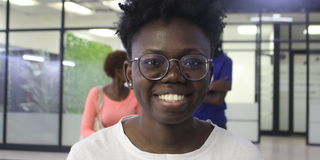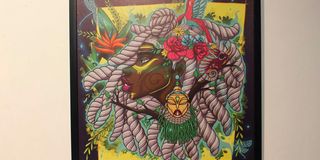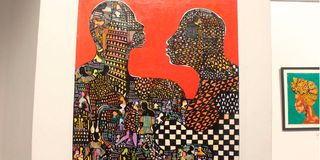Premium
Female artists shine in art exhibitions

Lynn Atieno, one of over 40 women artists exhibiting at Alliance Francaise on March 15, 2023.
Kenyan visual arts are typically known for being a male-dominated field. But this month in light of International Women’s Day on March 8, women artists have come ‘out of the woodwork’, emerging from their seemingly silent corners to appear on two of Nairobi’s main stages for public art, (places apart from the private galleries) namely Alliance Française and Kenya Cultural Centre’s Cheche Gallery.
Both Alliance and the Karakana Initiative sent callouts to female artists to show their best works to curators organising the two separate group shows.

Artwork in Malaika 2 exhibition at Cheche Gallery, at the Kenya Cultural Centre on March 11, 2023.
What is striking about the two exhibitions is that neither knew about the other, and both called out a completely different set of women artists.
The curators from Alliance called on women who had appeared in the Kenyan Arts Diary over the last decade.
They also called on women who had been featured in recent exhibitions, such as the ‘5 Lenses’ show in Westlands, the Pink Flames exhibition at the Village Market, and the U.M. women’s exhibition at the Waterfront in Karen.
Meanwhile, the Karakana curator, Nahya Mando of Art-a-Glance called on women members of the Kenya National Visual Arts Association, the Sanaa Art Universe collective, and Seloya, an arts NGO that works in Kibera with women.
All were asked to communicate with their female members to let them know they are invited to submit their art for consideration.
In all, there are 18 women in the “Malaika 2’ show in Cheche Gallery and 35 in “Her Story” at Alliance Francaise.

Chela Cherwon's Yath at Alliance Francaise in 'Her Story' exhibition, on March 15, 2023.
There is very little overlap between them apart from Eileen Tamining, a digital artist who’s exhibiting her work in both art spaces.
Otherwise, there is a myriad of new faces to the Kenyan art world being introduced this month, both at Alliance and at Cheche.
“We wanted to give young women artists an opportunity to exhibit their work,” Harsita Waters told the BDLife.
“At the same time, we invited several more established women painters and sculptors to bring their best works for consideration,” she added.
Among the ones best known both locally and overseas are sculptresses Chelenge van Rampelberg who has two fabulous wood sculptures in the show, and Maggie Otieno who also has two metal sculptures on display at Alliance’s ground floor gallery.
Sebawali Sio also brought her metal and coloured glass sculpture which stands next to Wambui Collymore’s mini-installation which she told the BDLife was about food inequality.

Sheila Bayley's Conversation at Alliance Francaise in 'Her Story' exhibition, on March 15, 2023.
Among the painters who have their work at Alliance are women like Anne Mwiti, Tabitha wa Thuku, Rahab Shine, Patti and Mari Endo, Chela Cherwon, Nadia Wamunyu, Sheila Bayley, Blaine Thuo and digital artist Lynn Atieno.
Lynn and Blaine had previously been in ‘5 Lenses’ at the Mall, and Niketa Fazel was instrumental in reviving the Kenya Arts Diary for 2023.
Even the troika of women artists who’ve been exhibiting together during the pandemic, namely Esther Mukuti, Nayea Sitonek, and Caroline Mburura, are in ‘Her Story.”

Lynn Atieno, one of over 40 women artists exhibiting at Alliance Francaise on March 15, 2023.
Plus many other incredible women artists are featured at Alliance. It’s a show that only opened officially on March 15, a week late, given International Women’s Day was March 8. But we agree it’s better to be late than not show up at all.
Meanwhile, the ‘Malaika 2’ exhibition at Kenya Cultural Centre featured many newcomers to the Kenyan art scene.
There are only 14 of them, and several are carry-overs from the exhibition that Karakana just brought down the day before it hung the current women’s exhibition.
My initial query had been why were there so many wildlife images in a show about women. I was told all of those animals had babies with them, meaning implicitly that the mature creatures were female.

'Black Boy Joy' painting by Lynn Atieno at Alliance Francaise in Nairobi during "Her Story' exhibition, on March 15, 2023.
That’s okay, but I think Ashna Kamande’s portraits of mama elephants and lions are more interesting because they are etched on rubber and finished with acrylics.
Otherwise, Nahya confirmed that most of the exhibiting women were ‘self-taught’ in that they had not gone to a formal art school.
But they all have the passion to produce a slew of polished pieces. The majority of them are portraits of lovely women.

Beauty by Ms Nganga at Malaika 2 exhibition at Cheche Gallery at the Kenya Cultural Centre on March 11, 2023.
However, since Steve Nderitu of the Karakana Initiative says the women’s exhibition will be an annual event, one hopes the women take that time to prepare new pieces specifically for Malaika 3 that are original, experimental, and slightly less stereotypic than what they presented this year.
We are just glad that so many newcomers showed their faces through their art this month. It is a hopeful sign.
***
This article was first published in the Business Daily




